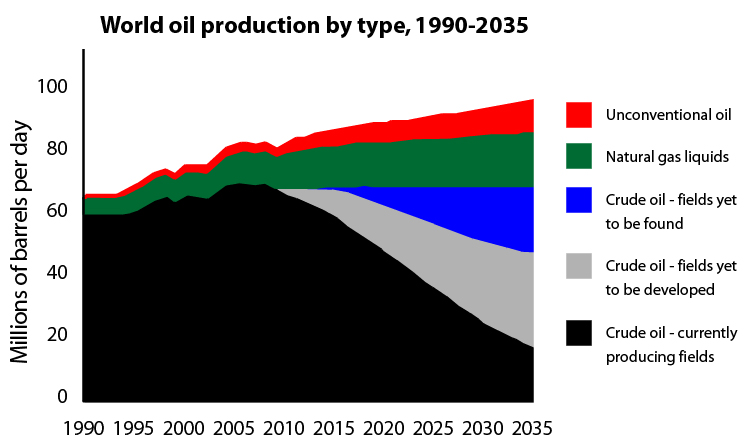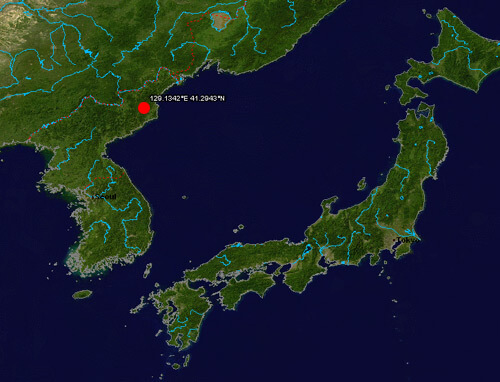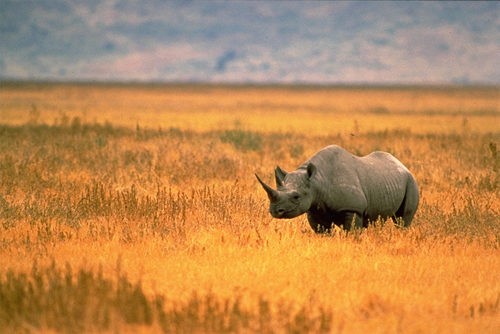
|
|
|
|
|
|
2006
Crude oil production is reaching a plateau
In 2006 – according to the International Energy Agency* – conventional crude oil production reached a plateau. This appeared to confirm what many had long suspected and feared: that the driver of humanity's progress for the last 150 years was now finally being exhausted.* There were major issues the IEA's report failed to address, such as where the crude oil for the next 25 years was expected to be discovered (to even maintain a plateau), the energy return on energy invested, the quality of energy from newly developed fields, the likely recession from higher prices, the political sensitivity of remaining reserves, and much more.*
By 2008, a combination of the falling U.S. dollar, Middle East tension, peak oil concerns and price speculation had led to a massive spike in the price of conventional crude oil. From only $30/barrel in 2003, it rose to $147/barrel in July 2008, contributing in part to the global financial crisis of that year.
Crude oil production began to recover in 2009, but at a slower rate than in earlier decades.* A revolutionary uprising in the Middle East – the Arab Spring of 2011 – added further uncertainty over supplies.

Global oil production as reported by the International Energy Agency
(IEA)
Twitter is launched
Twitter.com was launched in July 2006. This new method of social networking and micro-blogging grew rapidly. Within a few years, it was comparable with Facebook in terms of prominence. Many celebrities were using it to keep in touch with fans, while news outlets and businesses could give instant updates to followers. By 2012, Twitter had 500 million users, was generating 340 million "tweets" a day and handling 1.6 billion searches.

Pluto is demoted to "dwarf planet" status
From its discovery in 1930 until 2006, Pluto was considered the Solar System's ninth planet. In the late 1970s, following the discovery of minor planet 2060 Chiron and the recognition of Pluto's very low mass, its status as a major planet began to be questioned. Later, in the 21st century, many objects similar to Pluto were discovered in the outer Solar System, notably the scattered disc object Eris, which is 27% more massive than Pluto.
In August 2006, the International Astronomical Union defined the term "planet" for the first time. This definition excluded Pluto, instead adding it as a member of a new category – "dwarf planet" – along with Eris and Ceres. After the reclassification, Pluto was added to the list of minor planets and given the number 134340. A number of scientists continued to hold that Pluto should be classified as a planet.

Size comparison of Pluto and Earth.
North Korea conducts its first nuclear test
North Korea announced its intention to conduct a test on 3rd October, six days prior, and in doing so became the first nation to give warning of its first nuclear test. The blast was estimated to have an explosive force of less than one kiloton, and some radioactive output was detected.
An official at the North Korean Embassy in Beijing told a South Korean newspaper that the explosive output was smaller than expected. Due to North Korea's secretive nature and the small yield of the test, there were questions as to whether it was an unusually small successful test, or simply a dud.
In any case, international condemnation of this test was almost unanimous – including from North Korea's ally, the People's Republic of China. On 14th October 2006, the UN Security Council unanimously approved military and economic sanctions.

The West African black rhino is declared extinct
At the start of the 21st century, there were four subspecies of black rhino. In 2006, the World Conservation Union announced that one of the four subspecies, the West African Black Rhinoceros (Diceros bicornis longipe), had been tentatively declared extinct. Despite an exhaustive survey across Africa, none could be found, and there were none being held in captivity anywhere. The remaining three subspecies were critically endangered.

Saddam Hussein is executed
The execution of Saddam Hussein took place on 30th December 2006. He was sentenced to death by hanging, after being found guilty of crimes against humanity by the Iraqi Special Tribunal for the murder of 148 Iraqi Shi'ites in the town of Dujail in 1982, in retaliation for an assassination attempt against him.
Saddam Hussein was President of Iraq from 1979 until 2003, when he was deposed during the invasion of Iraq by a U.S.-led Allied Coalition. After his capture in ad-Dawr, near his hometown of Tikrit, he was incarcerated at Camp Cropper. On 5th November 2006, he was sentenced to death by hanging.
On 30th December, he was taken to the prison to be executed. The Iraqi government released an official videotape of the execution, showing him being led to the gallows, and ending after his head was in the hangman's noose. International public controversy arose when an unauthorised cellphone recording showed him falling through the trapdoor of the gallows. The audio – which was not in the official video – revealed taunts between Saddam and his executioners, many of whom were supporters of Muqtada Al-Sadr. The unprofessional and undignified atmosphere of the execution drew criticism from nations around the world.
On 31st December 2006, Saddam Hussein's body was returned to his birthplace of Al-Awja, near Tikrit, and was buried near the graves of other family members.

« 2005 |
⇡ Back to top ⇡ |
2007 » |
If you enjoy our content, please consider sharing it:
References
1 "Crude
output reaches an undulating plateau of 68-69 mb/d by 2020, but never
regains its all-time peak of 70 mb/d reached in 2006."
See World Energy Outlook 2010 – Executive
Summary, International Energy Agency:
http://www.worldenergyoutlook.org/docs/weo2010/WEO2010_ES_English.pdf
Accessed 16th November 2010.
2 Is 'Peak Oil' behind us?, New York Times:
http://green.blogs.nytimes.com/2010/11/14/is-peak-oil-behind-us/?_r=0
Accessed
3rd November 2013.
3 IEA World Energy Outlook 2010: Questionable Assumptions and Major Omissions,
The Oil Drum:
http://www.theoildrum.com/node/7102
Accessed
16th November 2010.
4 Key World Energy Statistics 2013, IEA:
http://www.iea.org/publications/freepublications/publication/KeyWorld2013_FINAL_WEB.pdf
Accessed 3rd November 2013.
![[+]](https://www.futuretimeline.net/images/buttons/expand-symbol.gif)






